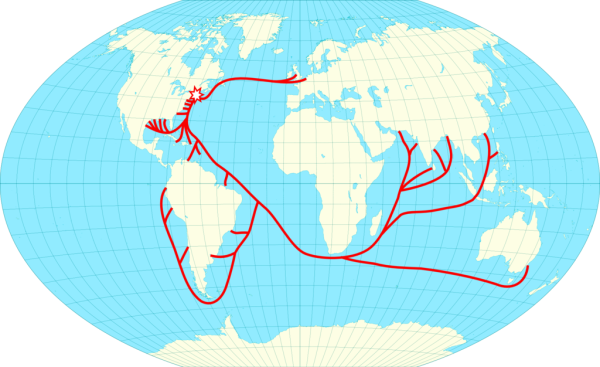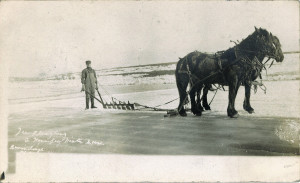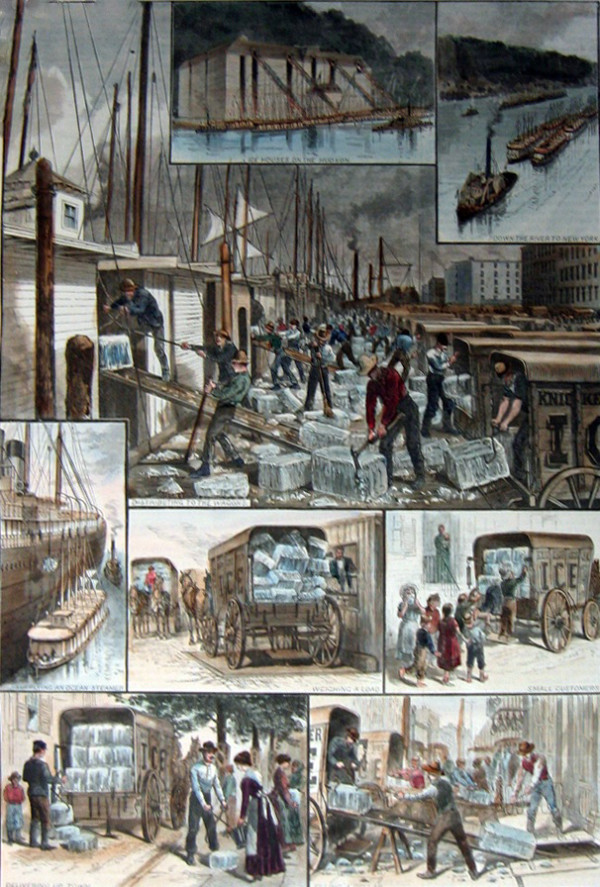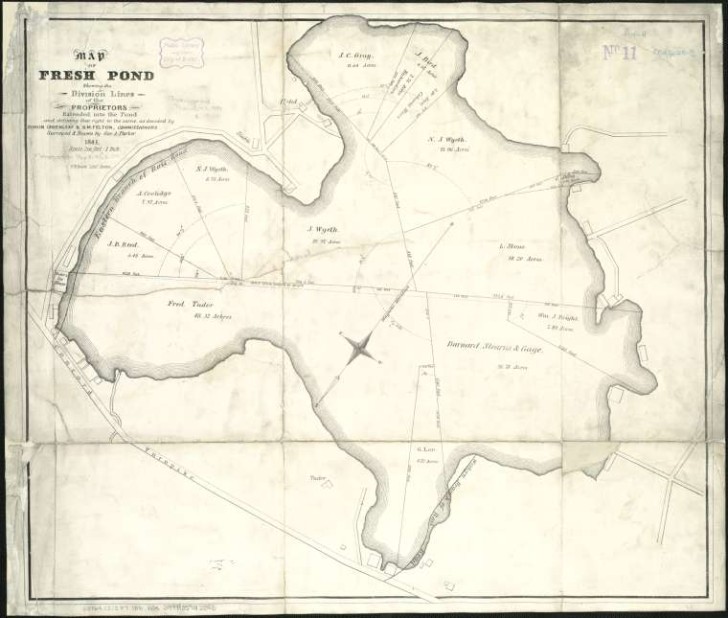In the mid-19th century, decades before home refrigeration became the norm, you could find ice clinking in glasses from India to the Caribbean, thanks to a global commodities industry that has since melted into obscurity: the frozen water trade.
In the cold Northeast of the United States, workers would cut ice from frozen ponds, haul it to port, put it on a ship and send it around the world on voyages that could last for months.

Fourteen inches of ice was thick enough to support the team of workers and horses assembled for the harvest. These workers would clear off snow and debris then score the exposed surface to create a grid of squares.

They used giant handsaws and ice pikes to break up the squares of ice, then maneuver the chunks to conveyor belts that lifted the huge cubes to nearby “ice houses.” From there, the ice would be shipped by rail and sea across the world. At its peak, this was a huge industry across New England.

Frederic Tudor got the ball rolling (or the cube sliding, as it were) for the whole global network. He was convinced that the local ice industry had global potential beyond regional food preservation. His perseverance eventually earned him the nickname “Ice King.”

Tudor set up shop on the banks of Fresh Pond in Cambridge, Massachusetts, just about two miles northwest of Harvard Square. He found that sawdust was a remarkably good insulator for storing and transporting the ice. It was remarkably cheap as well, a byproduct from lumber mills in Maine.
Though he was a self-taught expert at supply chain logistics, Tudor’s true genius was as a marketer. He had to convince consumers that they needed ice not just to store food but also to cool drinks. His marketing endeavors took him to bars, where he would give free samples and let patrons experience how refreshing a chilled beverage could be.
Tudor’s success did not go unnoticed, and as competitors swooped in and set up shop alongside him on Fresh Pond, a Harvard professor was conscripted to carve borders between competing ventures. The map above illustrates how ice rights evolved. Initially, they were tied to adjacent land ownership but rights were subsequently bought and sold separately on a secondary market. Even the property rights of ice that washed downstream became a source of disputes, thanks to the increased value of the commodity.

Decades later, the tide began to turn on the ice trade in America. Refrigerators began making their way into homes while ice-making factories offered an alternative to increasingly-polluted lake ice. As technology kept improving, fewer consumers opted to purchase natural ice scraped off the top of a frozen pond in favor of filtered frozen water from factories. A series of unusually warm winters, known as the “ice famine,” also contributed to the industry’s decline.
Today, regional hobbyists still try their hand at hacking huge cubes from frozen lakes, though such harvests are primarily for fun and festivals, providing material for local ice architects and sculptors. When it comes to chilling drinks, even ice harvest aficionados reach for their freezer.




Comments (20)
Share
Nice song-choice under the comparison of the ice king to a drug dealer.
Curtis Mayfield – Pusher man.
The Ice King is excellent. I love your podcast. The content and storytelling are excellent and you have built up a strong degree of trust in the quality of your research.
I did, however, find one thing in The Ice King really jarring and a bit disappointing. The episode starts with a description of two fictional British colonial officers being served a cold drink by an Indian servant. Then suddenly Roman Mars describes them as “wankers”. Where did that come from? Certainly the British behaved badly in India and colonialism was not a great moral enterprise. I also appreciate that this was a fictional story and you were not insulting any specific person. But the sudden expletive (which had little to do with the rest of the episode) was strikingly unprofessional and gratuitous. Not up to your usual high journalistic standard of jovial sobriety.
The odd thing is that your many historically based stories feature all kinds of crooks and villains and dictators. I don’t remember you describing any of them as wankers. Why all of a sudden pick on two fictional British colonial officers? Most of world history involves ordinary people carrying on lives which we wold now regard as being based on a morally reprehensible basis. Are you going to describe all of them as “wankers” too?
I couldn’t have put it better myself. Dissapointed Mr Mars…
I have some feedback on your episode, The Ice King. I love your podcast. The content and storytelling are excellent and you have built up a strong degree of trust in the quality of your research.
I did, however, find one thing in The Ice King really jarring and a bit disappointing. The episode starts with a description of two fictional British colonial officers being served a cold drink by an Indian servant. Then suddenly Roman Mars describes them as “w***ers”. Where did that come from? Certainly the British behaved badly in India and colonialism was not a great moral enterprise. I also appreciate that this was a fictional story and you were not insulting any specific person. But the sudden expletive (which had little to do with the rest of the episode) was strikingly unprofessional and gratuitous. Not up to your usual high journalistic standard of jovial sobriety.
The odd thing is that your many historically based stories feature all kinds of crooks and villains and dictators. I don’t remember you describing any of them as w***ers. Why all of a sudden pick on two fictional British colonial officers? Most of world history involves ordinary people carrying on lives which we wold now regard as being based on a morally reprehensible basis. Are you going to describe all of them as “w***ers” too?
Read the Plaque about an ice factory in Italy! http://readtheplaque.com/plaque/la-citt-delle-fabbriche
If you’d done this episode in the summer instead of the winter, I’d have been writing this comment while drinking iced coffee made with ice from Fresh Pond. These days, they don’t sell it pre-frozen, but people make it themselves because the tap water in Cambridge comes from Fresh Pond. Of course, it now goes through a water treatment plant before being used, so chopping up the frozen pond for drinks wouldn’t be a good idea.
In Northeastern Pennsylvania there’s a very small town called Eagle’s Mere. It’s reason for existence was first lumber, as was most of rural PA; then, ice harvesting. In the cool summers many wealthy Philadelphians would ride the railroad to their Victorian summer homes, many of which are still standing, and quite remarkable.
The town is shaped like a horseshoe around a lake. Every winter the local volunteer fire company hosts its annual fundraiser, the Eagles Mere Toboggan Slide. Ice is harvested from the lake, and hauled up the hill through town. Special grooves are carved into the blocks, stacked by the hundreds up the hill, beginning right on the lake. Toboggans with corresponding runners are available to rent, and speeds reach 40+ miles per hour.
Unfortunately, again this year the weather there has been too warm to allow sufficient ice thickness (8″ is needed) so the event is cancelled for 2016, but it’s a real throwback commemoration of local history.
Are the folks at 99PI fans of Adventure Time? Great episode as always.
The railroad in the Spy Pond picture is probably now the Minuteman Trail, a “rails-to-trails” path used by runners, walkers, and cyclists.
For those who are interested, Old Sturbridge Village, in Sturbridge, MA offers a hands-on ice harvesting demonstration during it’s “fire and ice” festival.
The link below shows the 2013 event.
https://www.osv.org/video/video-ice-harvesting-during-fire-ice-days-at-osv
https://www.osv.org/news/%E2%80%9Cfire-and-ice%E2%80%9D-days-at-old-sturbridge-village-jan-26-27
Pretty disappointed in this piece. Although it was interesting, there was no mention of the Arabs who were able to gather and store ice in the desert over 2000 years ago. Instead the emphasis was on how white people brought miracles to colonized India. Whether accidental or on purpose, this continues minimizing the strengths and achievements of people of colour while perpetuating the Eurocentric perspective.
https://en.wikipedia.org/wiki/Yakhchal
Great insight and a great lesson in history! I suspect that 99PI skipped over the Yakhchal (which were fascinating!) for two reasons:
1) The story was specifically about Tudor, not all forms of producing ice or all peoples who had ever produced ice. As another example, China had managed to make ice and store it (almost) year round in 1100 BC during the Zhou dynasty, which also wasn’t mentioned.
2) Frankly, the Yakhchal just weren’t all that good at actually making ice. Storing it, sure, they were ok I guess, but nowhere near as good as Tudor’s above ground ice houses and significantly more expensive to construct. Plus, with a Yakhchal, you’d better hope that you built it large enough at the start because expanding it is damn near impossible!
In the end, even though Arabs in the desert could make their own ice, they ended up buying Tudor’s ice because even after all the cost of shipping it around the horn of Africa, Tudor’s ice was not only cheaper than local ice, but it was also much higher quality. So while you’re right to point out that there were “Arabs who were able to gather and store ice in the desert over 2000 years ago,” the truth is that they really just weren’t that good at it.
There are plaques on Tudor Wharf in Charlestown.
http://www.waymarking.com/waymarks/WMH4Q_Signs_on_Tudor_Wharf
Fantastic use “wankers”, Roman. From an Aussie wanker.
Where can I find the music credits for this episode?
I was wondering the same.
Fabulous episode! One of my new favorites! It’s great to hear about such common and important aspects of life that have fallen into relative obscurity.
Just wanted to say that this episode, although quite interesting, was disappointing.
a) It continues the suppression of contributions made by people of colour throughout history, continuing to promote a Eurocentric point of view.
b) It continues to frame people of European descent as superior (in this case, the Americans and the British) and people of colour (in this case Indians) as inferior by displaying the colonial relationship as one that brought miracles to the lives of Indians who would be lost without them.
One example of the contributions of people of colour regarding Ice Storage and transport comes from Iran. The practice of transporting and storing ice in the desert has been around for over 2000 years. Look into the Yakhchal.
As life would have it, the ice trade has come full circle, as the very infrastructure which killed the original ice trade now begins to age and deteriorate the need for a new consistent ice option has arisen. A new market has been established for consumers looking to eliminate the variances associated with locally produced ice, and this often overlooked commodity is experiencing a new renaissance.
I am still catching up and have been for a while. So this is coming late. First of all, in keeping with Radiotopia, I am also catching up on the Memory Palace, who also has an episode on the New England ice trade. Both very good pieces, and very interesting to see the different takes.
However, I cannot believe that as design fans, you have missed to mention (or honor with an own episode, at least until here) the Yakchal , or the Persian ice house(https://en.wikipedia.org/wiki/Yakhch%C4%81l or just type “Persian Ice House” into your favourite search engine), an antique architectural structure that allows you to make ice in what is today Iran, not a place known for its frosty climate. Maybe you want to have a look?